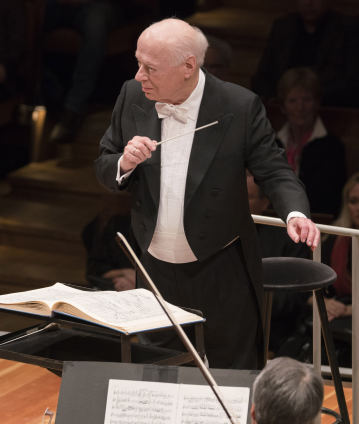Bernard Haitink conducts Mahler’s Ninth Symphony

It is almost inconceivable today that Gustav Mahler’s works were long marginalised in musical life. Bernard Haitink, who has an exceptionally fine feel for the fragmented nature of this music, is one of the conductors who brought about the Mahler renaissance in the 1960s. Mahler, says Haitink, “has always troubled me because he doesn’t validate you”. In this concert, he conducts Mahler’s farewell to the world, the Ninth Symphony.
When Bernard Haitink was appointed chief conductor of the Concertgebouw Orchestra in 1961, the Mahler tradition in the Netherlands, begun by Willem Mengelberg, had long since faded as a result of Nazi dictatorship and the Second World War: “He [Mahler] was forbidden in my country until 1945. [...] There was no more Mahler tradition, and the music was really new. I remember that Erich Kleiber performed the Third. But that was much later.” Despite this background, Bernard Haitink made a significant contribution to the Mahler renaissance which began in the early 1960s and which earned him the reputation of an outstanding Mahler conductor: “Mahler”, he says, “has always troubled me because he doesn’t validate you.”
A partner of the Berliner Philharmoniker for many years, the Dutch maestro now conducts Mahler’s Ninth Symphony, a work of an exceptional nature: even Bruno Walter described the first movement of Mahler’s last completed symphony as “a tragically harrowing, and noble paraphrase of that feeling of farewell”. In the second movement, we then hear shadowy forms of a variety of dance modes, described by Dieter Schnebel as ʻcomposed ruinsʼ. The brittle music, which sometimes takes on demonically grotesque characteristics, culminates in a wild “Danse macabre”, in which the violins – like the solo violin in the Totentanz Scherzo of the Fourth – have to play “like fiddles”. This is followed by a Rondo-Burleske of agitated bustle whose raging tornado “takes the mild irony of the Fischpredigt Scherzo from the Second Symphony and raises it to a level that is barely tolerable” (Jens Malte Fischer). The finale, with its characteristic turn motif, offers no apotheosis. Instead, what is heard is an expansively sung Adagio which employs “his whole arsenal of vocables expressive of grief from Mahler’s tonal language” (Hans Heinrich Eggebrecht). The final part, played only by strings “with heart-felt emotion”, ends in a dying ritardando.
No wonder that the key analyses of the symphony since the posthumous premiere have revolved around concepts such as “farewell” and “death”. Given the many emotional moments, according to Haitink, the work offers great challenges: “For Mahler, it is important that you get the dynamic nuances right, so that not everything is a hotch-potch in mezzo forte. [...] Karajan once said that there is only one climax in a piece, and how important it is not to use all your ammunition at once. So you have to pace yourself [...].”
© 2017 Berlin Phil Media GmbH
Artists
Our recommendations
- 1993 Europakonzert from London with Bernard Haitink and Frank Peter Zimmermann
- Bernard Haitink conducts Mahler’s First Symphony
- Bernard Haitink conducts Mahler’s Third Symphony
- Bernard Haitink conducts Schubert and Mahler
- Bernard Haitink conducts Mahler’s Second Symphony
- Brahms’s Violin Concerto with Frank Peter Zimmermann and Bernard Haitink